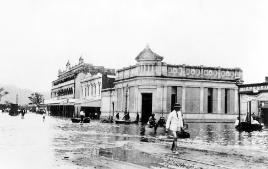Floods a part of Rocky's history
Published on 24 January, 2011
As Rockhampton begins to recover from the fourth highest flood ever recorded, images of the city's Great Flood of 1918 remind us how history repeats itself.
As we wash down the walls, scrape down the sludge, rebuild our businesses and homes and slowly come to terms with our losses, it's deja vu for many locals, some of whom also survived the 1954 and 1991 flood events.

Going to work with bare legs ... Rockhampton's CBD.But it is images of the biggest flood back in 1918 that frightened many recently, as the waters rose and the expected heights juggled between 9 and over 10 metres - a measure that threatened hundreds more homes and thousands of people.
According to CQUniversity's Rockhampton flood historian Dr Barbara Webster, Rockhampton is no stranger to flooding, having been settled around the Fitzroy River which boasts the second largest catchment in Australia. In fact, she has provided an insight into the wrath of this river in her book entitled Marooned - Rockhampton's Great Flood of 1918.
"In that catastrophic event, eight people drowned and hundreds of houses and businesses were awash in Rockhampton and the then-separate township of North Rockhampton. Both were isolated for three weeks or more as floodwater cut railway lines and roads and severed water, electricity, gas, telephone and telegraph services," she explained.
"There was no early warning system in 1918, no SES or Red Cross, and no helicopters, heavy machinery or pressure hoses. All the same, people were rescued and given refuge, food supplies were maintained by boat and by slaughtering cattle from the river, and streets and houses were cleaned up as the waters receded. And it was the locals that did those tasks - police and special ‘flood constables', aldermen and their wives, church organisations, council workers, and neighbourhood and family groups."
In some ways, the flood victims of 1918 fared reasonably well, some would say better than we do today. Most homes in these early years had solid timber walls, unlike today's plasterboard walls which suffer badly after water inundation and need to be removed and replaced. Most of the people who were flooded also had fewer material things to lose, particularly of the electrical kind - a blessing in disguise as horse and cart and rowboat was the only way to remove possessions to higher ground. For those not flooded out, but cut off by waters, Dr Webster believes having a rainwater tank, wood stove and ‘chooks' in the backyard helped to ease the burden of disrupted services and supplies.
Similar to today, many were evacuated from their homes, taking refuge with relatives, church halls and schools. There were reports of sightseers, especially from well-to-do parts of town, their boats causing wakes that made life worse for those still in their homes. Kids played in the water, police cautioned of the dangers and people's trust was compromised.
Dr Webster said: "Akin to the recent situation, news reporters, photographers and ‘cinematographers' abounded and police warned children of the dangers of flood waters and intending looters to beware."
Although this month's flood waters threatened the CBD, waters peaked under the expected 9.4m, (that would have matched the 1954 flood) at 9.2m, and most central businesses were spared the devastation. Back in 1918 water came up to the corner of East and William Street (where Subway and Strutters nightclub now stands). This became the drop off point for boats carrying people from the flood-inundated suburb of Depot Hill. Water was also in Quay Street and Bolsover Street to the City Hall corner.
"With state and local elections a few weeks away, politicians weighed in on the event too. And, as happens in natural disasters and will inevitably occur in 2011, after a few weeks, the spirit of cooperation gave way to bickering, accusations of fund mismanagement and contesting ideas about how Rockhampton could be flood proofed," said Dr Webster, who later explained this classic post-natural disaster behaviour had plenty of research to back it up.
And questions have already started to emerge. Member for Rockhampton Robert Schwarten this week spoke to The Morning Bulletin about a 19-year-old plan for flood-proofing Rockhampton which was born out of the damage and isolation caused to the city by the 9.3m high flood of 1991. As flood memories faded, much of this report has remained dormant after its release, but now it seems people want answers. There will surely be billion dollar figures waved around and promises made, but flood proofing Rockhampton will never be an easy task. Floods have been a part of this city for longer than white settlers can remember. It's been reported that the Aboriginal people from the area told stories of mega-inundations where a sea of brown water stretched virtually from Mount Archer to the Mount Morgan range.
"When the first white people came here in the late 1850s, Aborigines told stories of huge floods. They used to retreat to the top of ‘The Range' because everything else was flooded. When one H Parsloe arrived in 1863, he saw flood debris five metres up in a tree outside the present School of Arts and Library. Elderly people told The Morning Bulletin reporters these stories back in 1918," Webster said.
The spirit and determination of Rockhampton's people back in 1918 mirrors much of what we have seen today. Neighbours helped neighbours, community groups came to the rescue and efforts were made to get business back to usual as quickly as possible. If there is something to learn from our city's flood history, it is that we can be assured it will happen again.
Marooned: Rockhampton's Great Flood of 1918 was published by the Cooperative Research Centre for Coastal Zone, Estuary and Waterway Management Brisbane.
Photos compliments of CQUni Library Capricornia Central Queensland Collection

